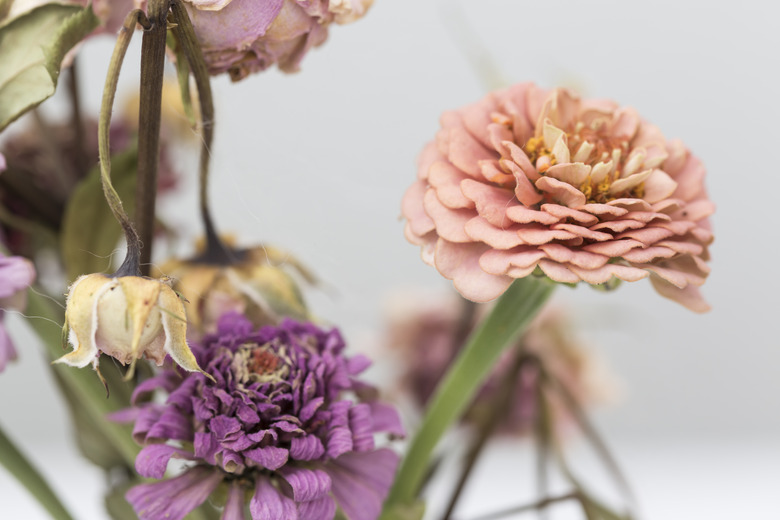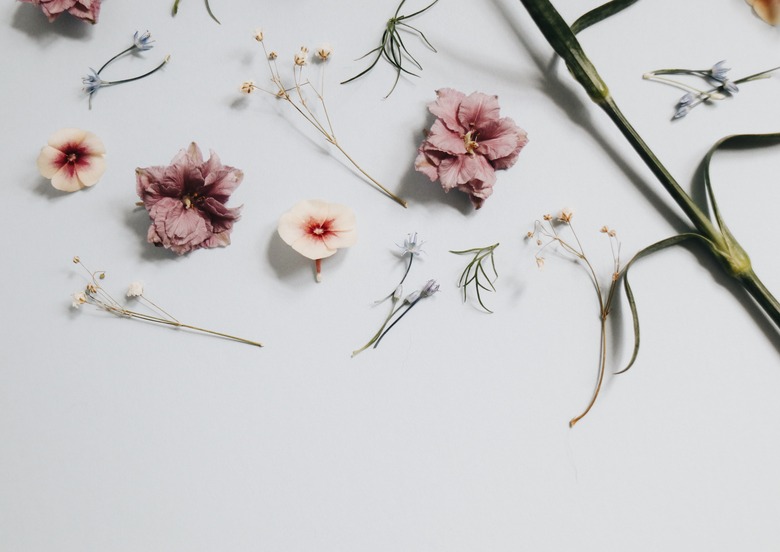How To Preserve Flowers
Flowers dried from special occasions can evoke powerful memories and, when pressed into a scrapbook, they emit a scent when you turn the page.
Luckily, you have several options for preserving flowers. The simplest is to hang them upside-down and air-dry them, but you can also use desiccants or glycerin. Certain types of flowers lend themselves to certain drying methods as well.
Prep for Preserving Flowers
Before tackling any of these methods, make sure you have picked the flowers at the right time and that they are ready to dry. Here are the basics:
- Pick flowers just before they are in full bloom, because flowers past their peak don't hold their color well.
- Pick more flowers than you think you need, because dried flowers shrink up more than you might realize.
- Remove all leaves before drying, because the foliage, when dried, will not retain its shape but will just crumble.
Air-Drying Flowers
Air-drying is the simplest method. After harvesting and removing leaves, tie your flowers into a small bundle—use fewer flowers in a bundle if the blooms are large and more if they are small. You want to make sure that air can circulate around each stem and flower, so don't pack them together too tightly.
Hang the bundles from a clothesline or dowel in a room with low humidity, which is likely not your garage unless you live in a warm or very dry climate.
The time to complete drying will differ, largely depending on the flower and which parts you are drying. Baby's breath, for instance, has tiny flowers and will dry more quickly, while hydrangea will take longer.
Using Desiccants to Dry Flowers
Some flowers dry better if you use a drying material rather than just air-drying them. These include those that are likely to wilt before they are fully dry, such as roses, begonias, geraniums or pansies, for instance.
Many materials can be used as a desiccant, including silica gel, sand, sawdust, cornstarch, borax, perlite or some combination. Professional florists prefer commercially prepared mixtures, but these are expensive. Here are a few ways to make your own:
Borax Blends
- Blend equal parts borax and cornmeal, borax and dry sand or borax and oatmeal. Avoid using beach sand as it may contain salt, which will damage the plant material.
- Mix 1 part borax with 5 to 10 parts other materials, putting the emphasis on other drying agents, which is preferred by some professionals. You also can substitute no-bleach detergent for the borax.
Silica Gel
Purchase silica gel from a hobby or craft shop. Although silica can be expensive, it can be reused, and it is also a gentle way to dry delicate flowers. Immerse the flowers in a container filled with silica for two to seven days. Silica will become a pinkish-gray when it has absorbed the moisture.
Dry them for future use in a shallow pan in the oven set at 250°F for several hours, or use a microwave for a few minutes. When they are their original blue color, they are ready to use.
Using Glycerin for Some Flowers and Foliage
Glycerin is particularly effective for preserving foliage, because it replaces the moisture in the leaf to preserve it, not only its color, but also sometimes its texture.
Mix glycerin with water at a specific ratio, which depends on the type of foliage:
- Thick leaves and stems: 1 part glycerin to 2 parts water
- Medium-bodied leaves an stems: 1 part glycerin to 2 1/2 parts water
- Thin or fine-textured leaves and stems: 1 part glycerin to 3 parts water
When harvesting plants for glycerin treatment, avoid watering them just before harvesting, as dry stems and leaves will uptake more glycerin. For stems, cut them 4 to 6 inches longer than you need; then lightly crush the extra stem parts with a hammer, so the cell walls are broken and will absorb more glycerin.
Heat water to 150 to 180°F, add the glycerin in the ratio you have selected and stir until cooled. Submerse the stems, leaving them in the solution for two to six weeks. Maintain the level of the solution by adding water. The foliage should turn a greenish-brown. Remove from the solution and hang upside-down for a few days.

